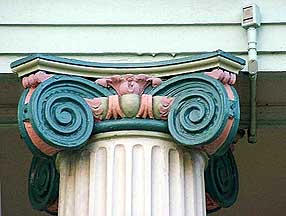Illustrated Architecture Dictionary........................ Greek Revival Style
Ionic order


Palladio's Drawings of the Five Classical Orders
Click on drawing for larger size
Four drawings reprinted from Dover Pictorial Archive Service
Palladio's Drawing of the Ionic Frieze
Block modillions support overhanging eaves ... Egg-and-dart molding ... Leaf-and-dart molding ... Bead-and reel molding ... Ionic capitals ... Fluted shafts
Palladio's Drawing of the Ionic Capital
Leaf-and-dart molding ... Scrolling acanthus leaves ... Pair of volutes flank egg-and-dart molding above beads ... Fluted shafts
Palladio's Drawing of the Ionic Baluster
Greek Ionic Order:
The Greek Ionic order is composed of the following:
- Entablature
- Column capital
- Column shaft
- Column base
Ionic entablature: Three major parts include cornice, frieze, and architrave.
- The cornice sometimes includes modillions, dentils, anthemion, and egg-and-dart.
- The frieze sometimes includes sculpted relief ( in the area where the Doric order is articulated with triglyphs).
Ionic column: The slenderest and most ornate of the three classical Greek columns, including tallest base of the three classical Greek orders
Ionic capital: The capital of the Ionic column has characteristic paired scrolling volutes. The major features of the Ionic order are the volutes of its capital.
- The capital is usually enriched with egg-and-dart.
- Baluster: The roll forming the side of an Ionic capital. Also known as a pulvinus.
Ionic shaft: Slender fluted shaft (24 flutes)
Ionic base: Unlike the Greek Doric order column, Ionic columns normally stand on a base which separates the shaft of the column from the stylobate or platform.
Engaged column: also employed Orders
Ionic pilasters: also employed Orders
Roman Ionic Order: The main difference is that Romans used smooth - as opposed to fluted - shafts. The Romans used the Ionic order much more than did the Greeks.
In GeneralThe Orders of classical architecture were formalized by the Greeks and applied to the design and proportion of buildings used the post-and-lintel, or column and entablature construction
The Ionic order column originated in the mid-6th century BC in Ionia, the southwestern coastland and islands of Asia Minor settled by Ionian Greeks, where an Ionian dialect was spoken. The Ionic order column was being practiced in mainland Greece in the 5th century BC
The other two classical Greek orders were the Doric and the Ionic (which also features volutes, although proportionately larger). The Ionic column is always more slender than the Doric.
A pure Ionic mode seen on the Athenian Acropolis is the Erechtheum
From the sixteenth century onwards, theorists recognized five orders, including the three Greek orders plus the Roman Tuscan and Composite orders.
See also: Vitruvius Pollio on Doric, Ionic and Corinthian Orders (The Greeks were first to declare that architecture was based on the proportions and form of the human body.
Examples from Buffalo:
- Left illustration above: Albright-Knox Art Gallery
- Right illustration above: Dr. E. J. Meyer Building
- Pomeroy House
- First Church of Christ, Scientist / Karpeles Manuscript Museum
- Reading room, Buffalo Catholic Institute Public Library / Church of Scientology
- Albert F. Laub Mausoleum, Forest Lawn Cemetery
- Williams Pratt Mausoleum, Forest Lawn Cemetery
- 109 Chapin Pkwy ........... Detail
- Wendt House Capital
- First Baptist Church / 14 North Capital
- Wendt House Column
- Photo: 1036 Broadway
- Photo: 444 Linwood Ave.
Other examples:
